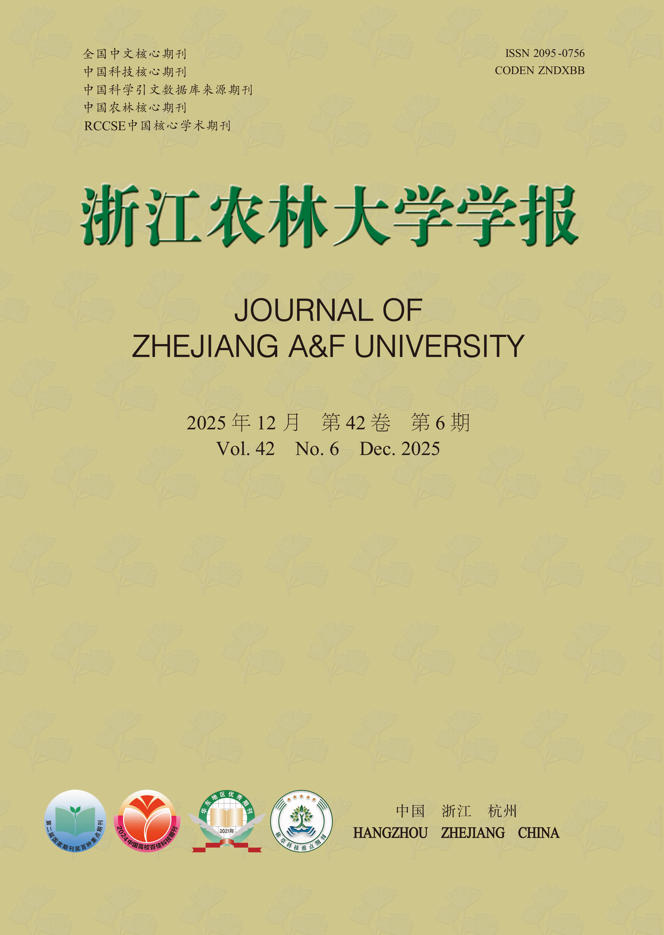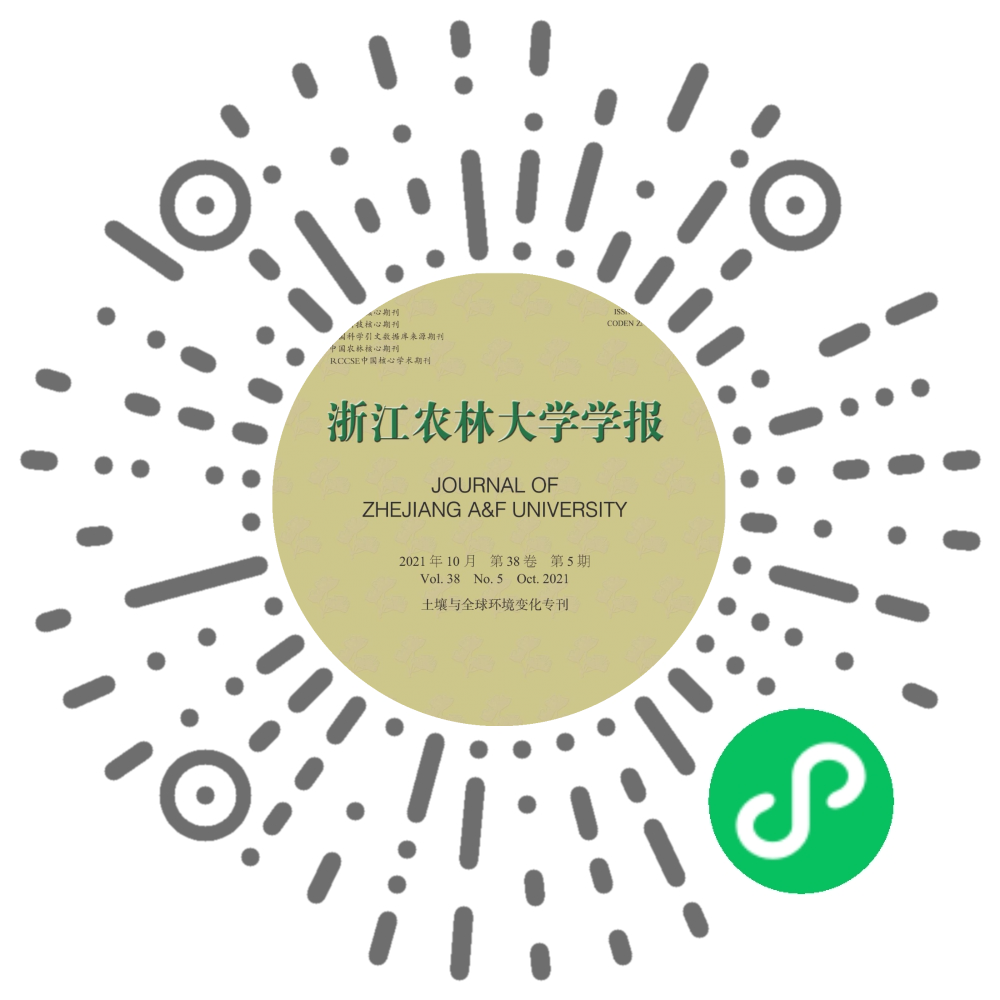1995 Vol. 12, No. 2
1995, 12(2): 121-127.
Abstract:
The leaves, veins, lenticels, twig clors and flowers of 64 Chinese chestnut clones or strains were observed in the Chinese chestnut orchard of Tonglu Forest Farm, Zhejiang ProVince, and the apertures, shapes and ornamentation of pollen to 20 ones among them were scanned by use of electron microscope (3000 times). Some diversities among the clones or strains were found in the shape, tickness and hair of leaf, lenticular density and color of twig. The polar faces and ornamentation of pollen were basically same, but some diversities on the germ furrow depth, equatorial face and size of pollen were osberved.
The leaves, veins, lenticels, twig clors and flowers of 64 Chinese chestnut clones or strains were observed in the Chinese chestnut orchard of Tonglu Forest Farm, Zhejiang ProVince, and the apertures, shapes and ornamentation of pollen to 20 ones among them were scanned by use of electron microscope (3000 times). Some diversities among the clones or strains were found in the shape, tickness and hair of leaf, lenticular density and color of twig. The polar faces and ornamentation of pollen were basically same, but some diversities on the germ furrow depth, equatorial face and size of pollen were osberved.
1995, 12(2): 128-132.
Abstract:
Doramnt buds, regenerative materials from sprouts of Cunninghamfa lanceolata, are numerically related to regeneration success or failure. Observation for the base parts of sample trees revealed the factors influencing the number of dormant buds of Chinese fir. The results suggested that the quantity of dormant buds changed with site quality, with the better the sites, the less the dormant buds, containing less dormant buds in trees from the centre of their distribution areas than those from their peripheral parts. In a same sand, more dormant buds developed in the large size-class trees than the samll ones. Dormant buds increased with the development of the sand, and culminated in the middle-age, then decreased with the age growth. Crop age and site quality were main factors influencung the number of dormant buds. The authors recommended some reasonable suggestions about regeneration practice.
Doramnt buds, regenerative materials from sprouts of Cunninghamfa lanceolata, are numerically related to regeneration success or failure. Observation for the base parts of sample trees revealed the factors influencing the number of dormant buds of Chinese fir. The results suggested that the quantity of dormant buds changed with site quality, with the better the sites, the less the dormant buds, containing less dormant buds in trees from the centre of their distribution areas than those from their peripheral parts. In a same sand, more dormant buds developed in the large size-class trees than the samll ones. Dormant buds increased with the development of the sand, and culminated in the middle-age, then decreased with the age growth. Crop age and site quality were main factors influencung the number of dormant buds. The authors recommended some reasonable suggestions about regeneration practice.
1995, 12(2): 133-138.
Abstract:
In the northern subtropics of China, in a 28-year-old Chinese fir stand grown on yellow-brown soil, 5 treatments of various cutting seasons were established to study the differences in nitrogen nutrition, endohormones, sprouting amount and growth rate of the sprouting dormant buds from Chinese fir stumps. It turned out that winter cut (Dec. 8 of last year) and early spring cut (Mar.8 of the current year) were the optiaml cutting seasons by which the sprouting amount from a stump, the N nutrition Ievel in the sprouting buds and the growth rate of sprouts were the highest. Sprouting amount per stump was closely related to CTK level in sprouting buds, while the difference of N nutrition in the sprouting buds from various stumps was mainly attributed to the translocation of N nutrients within the tree, especially the downward reflux of reductive N to the basal Part of stem and root system. The ring-barking experiment further proved this inference. Therefore, the concentrations of total N and amino N in the sprouting buds can be adopted as the physiological indice for demonstrating the optimal cutting season and predicting the growth rate of sprouting.
In the northern subtropics of China, in a 28-year-old Chinese fir stand grown on yellow-brown soil, 5 treatments of various cutting seasons were established to study the differences in nitrogen nutrition, endohormones, sprouting amount and growth rate of the sprouting dormant buds from Chinese fir stumps. It turned out that winter cut (Dec. 8 of last year) and early spring cut (Mar.8 of the current year) were the optiaml cutting seasons by which the sprouting amount from a stump, the N nutrition Ievel in the sprouting buds and the growth rate of sprouts were the highest. Sprouting amount per stump was closely related to CTK level in sprouting buds, while the difference of N nutrition in the sprouting buds from various stumps was mainly attributed to the translocation of N nutrients within the tree, especially the downward reflux of reductive N to the basal Part of stem and root system. The ring-barking experiment further proved this inference. Therefore, the concentrations of total N and amino N in the sprouting buds can be adopted as the physiological indice for demonstrating the optimal cutting season and predicting the growth rate of sprouting.
1995, 12(2): 139-143.
Abstract:
Adopting various forestation techniques, a good mixed benefit has been obtained from the mixed forests ofLiquidambar formosana andCupressus funebrisorPinus massoniana orPinus elliottii, which were made in the different types of land in limy red soil, acid soil and Plate-like rocky soil. The broad-Ieaved mixed forest takingLiquidambar formosanaas leading species-with high productivity and beautiful forest form, could be directionally transformed by closing hillsides to facilitate afforestation.
Adopting various forestation techniques, a good mixed benefit has been obtained from the mixed forests ofLiquidambar formosana andCupressus funebrisorPinus massoniana orPinus elliottii, which were made in the different types of land in limy red soil, acid soil and Plate-like rocky soil. The broad-Ieaved mixed forest takingLiquidambar formosanaas leading species-with high productivity and beautiful forest form, could be directionally transformed by closing hillsides to facilitate afforestation.
1995, 12(2): 144-148.
Abstract:
The growth characteristics in DBH, height and volume of Taxodium ascendens which was Planted in seasonal watering sites of Qingshan Reservoir were analysed. The results showed that taking seasonal watering days, plough layer deepness and soil drainage in no watering periods as site type determinants was reliable and proper. The effects of different sites on the growth of T.ascends were quite great. Its growth process could be divided into four stages: sapling stage, fast-growing stage, tree stage and slow-growing stage.
The growth characteristics in DBH, height and volume of Taxodium ascendens which was Planted in seasonal watering sites of Qingshan Reservoir were analysed. The results showed that taking seasonal watering days, plough layer deepness and soil drainage in no watering periods as site type determinants was reliable and proper. The effects of different sites on the growth of T.ascends were quite great. Its growth process could be divided into four stages: sapling stage, fast-growing stage, tree stage and slow-growing stage.
1995, 12(2): 149-155.
Abstract:
The hybrid which was produced from Liriodendrone chinense (L1)xL. tulipifera (L2), at 16 years old, had 60.8% and 32.1% greater than L1 and L2 respectively in mean DBH, 31.4% and 10.6% in mean height, and 233.5% and 94.4% in above-ground bioamss. L1, L2 and their hybrid were different in morphological characters. Three mathematical models for calculating biomass were selected. In Suichang, Chunan and Linan County of Zhejiang Province, L.starred in a mixed forest were mostly dominant trees, with 16.83 cm DBH at 10 years old, 18.45cm at 12 year sold, and 23.50 cm at 15 years old. Current annual increment involume peaked at 13 years old or so. According to the bioecology, a set of culture techniques for L. was made.
The hybrid which was produced from Liriodendrone chinense (L1)xL. tulipifera (L2), at 16 years old, had 60.8% and 32.1% greater than L1 and L2 respectively in mean DBH, 31.4% and 10.6% in mean height, and 233.5% and 94.4% in above-ground bioamss. L1, L2 and their hybrid were different in morphological characters. Three mathematical models for calculating biomass were selected. In Suichang, Chunan and Linan County of Zhejiang Province, L.starred in a mixed forest were mostly dominant trees, with 16.83 cm DBH at 10 years old, 18.45cm at 12 year sold, and 23.50 cm at 15 years old. Current annual increment involume peaked at 13 years old or so. According to the bioecology, a set of culture techniques for L. was made.
1995, 12(2): 156-160.
Abstract:
Ligustrum vicaryi, a tree species with gold-colored leaf, was introduced into Hangzhou from Beijing in 1991. The results of cultivation for three years in successition suggested that three-year-old young tree had made good growth, with a crown diameter of 80cm. Its vegetative propagation could easily operated in summer or autumn, rooting quickly after cuttings be earthed, with above 90% survival rate. For this species, summarize a set of good vegetative reprodeution method sand culture techniques, analyze its garden value and effect in garden plants setting, give a popularizing conclusion used as a color leaf-and modelling plant.
Ligustrum vicaryi, a tree species with gold-colored leaf, was introduced into Hangzhou from Beijing in 1991. The results of cultivation for three years in successition suggested that three-year-old young tree had made good growth, with a crown diameter of 80cm. Its vegetative propagation could easily operated in summer or autumn, rooting quickly after cuttings be earthed, with above 90% survival rate. For this species, summarize a set of good vegetative reprodeution method sand culture techniques, analyze its garden value and effect in garden plants setting, give a popularizing conclusion used as a color leaf-and modelling plant.
1995, 12(2): 161-165.
Abstract:
The rate of leaf-extracts of lndocalamusmigoi and Indocalamus latifolius were 9.69% and 11.90% respectively. The former's extract held a maximum of fructose, then glucose, mannose and the others; the latter's contained a height of arabinose, next fructose, mannose and the others. Glutamic acid , arginine, alanine, asparagine and serine were main amino acids in the leaf-extracts. In water-soluble vitamins, the former's vitamin C, niacin, folic acid and vitamn B were relatively high, and vitamin B6, choline and pantothenic avid were not found; the latter's niacin, vitamin C, vitamin B1 were relatively high, and vitamin B6, vitamin B2, folic acid, pantothenic acid and choline were not found. The contents of some microelements and common elements were also determined.
The rate of leaf-extracts of lndocalamusmigoi and Indocalamus latifolius were 9.69% and 11.90% respectively. The former's extract held a maximum of fructose, then glucose, mannose and the others; the latter's contained a height of arabinose, next fructose, mannose and the others. Glutamic acid , arginine, alanine, asparagine and serine were main amino acids in the leaf-extracts. In water-soluble vitamins, the former's vitamin C, niacin, folic acid and vitamn B were relatively high, and vitamin B6, choline and pantothenic avid were not found; the latter's niacin, vitamin C, vitamin B1 were relatively high, and vitamin B6, vitamin B2, folic acid, pantothenic acid and choline were not found. The contents of some microelements and common elements were also determined.
1995, 12(2): 166-171.
Abstract:
Some aspects of V-belts drive of BX218 type chippers were analysed. Improvement designs were made by the optimum design method. The driving properties were obviously improved.
Some aspects of V-belts drive of BX218 type chippers were analysed. Improvement designs were made by the optimum design method. The driving properties were obviously improved.
1995, 12(2): 172-179.
Abstract:
The genus Phronia Winnertz from China is reviewed. A key to 14 species known from China is presented. Two unnamed species are described as new to science, and 3 named species are listed for the first time from China. The new species are as follows: blattocauda, gutianshana. The new Chinese recorded species are: braueri Dziedzieiki, taczanowskyi Dziedzicki and willistoni Dziedzicki. The type specimens are deposited in the Insect Collections of Beijing Agricultural University and Zhejiang Forestry College respectively. Some paratypes are preserved in Gutianshan Nature Reserve and Baishanzu Nature Reserve, Zhejiang Province respectively.
The genus Phronia Winnertz from China is reviewed. A key to 14 species known from China is presented. Two unnamed species are described as new to science, and 3 named species are listed for the first time from China. The new species are as follows: blattocauda, gutianshana. The new Chinese recorded species are: braueri Dziedzieiki, taczanowskyi Dziedzicki and willistoni Dziedzicki. The type specimens are deposited in the Insect Collections of Beijing Agricultural University and Zhejiang Forestry College respectively. Some paratypes are preserved in Gutianshan Nature Reserve and Baishanzu Nature Reserve, Zhejiang Province respectively.
1995, 12(2): 180-185.
Abstract:
The southern blight of Loropetalum chinense var. rubrum is a serious disease which incidences in the cutting beds, and is infected by Sclerotium rolfsii. Its hosts have reached above 20 tree species, with a disease incidence of 27.1% to 96.7%. It damages not only the stock's bases and roots, but also the other sections, and causes soft moist rot or dry rot. It prevailes from June to November and the peak of invasion is from July to August. Its incidence rate is closely related to the practice timethe moisture conditions of the cutting beds. The control could made at the first incidence and the effects of spraying the tree crown with 500-fold solution of kitazin 40EC or 500-fold triadimefon 20EC were over 89.8%.
The southern blight of Loropetalum chinense var. rubrum is a serious disease which incidences in the cutting beds, and is infected by Sclerotium rolfsii. Its hosts have reached above 20 tree species, with a disease incidence of 27.1% to 96.7%. It damages not only the stock's bases and roots, but also the other sections, and causes soft moist rot or dry rot. It prevailes from June to November and the peak of invasion is from July to August. Its incidence rate is closely related to the practice timethe moisture conditions of the cutting beds. The control could made at the first incidence and the effects of spraying the tree crown with 500-fold solution of kitazin 40EC or 500-fold triadimefon 20EC were over 89.8%.
1995, 12(2): 186-192.
Abstract:
On the basis of analyzing the current situations and characteristics of information process for Chinese forest tree seed and seedling management, using theory of system and management science, the author worked to probe from all sides for a frame of the inforamtion process, including level, structure, function, data classfication, information rules, adopted techniques and methods.
On the basis of analyzing the current situations and characteristics of information process for Chinese forest tree seed and seedling management, using theory of system and management science, the author worked to probe from all sides for a frame of the inforamtion process, including level, structure, function, data classfication, information rules, adopted techniques and methods.
1995, 12(2): 193-197.
Abstract:
Citations were statistically analyzed to 396 articles from Jounnal of Zhejiang Forestry College published in 1989~1993, with 5 aspects: citation quantity, document type, language coverage, time coverage, main quited periodicals, compared with the situations of similar journals. The results showed that each article avaraged 6.30 citations, in which periodicals accounted for 61.25%, books for 37.11%, with Chinese documents accounted for 82.91% published in the last 10 years, foreign documents for 56.37% in the last 15 years.
Citations were statistically analyzed to 396 articles from Jounnal of Zhejiang Forestry College published in 1989~1993, with 5 aspects: citation quantity, document type, language coverage, time coverage, main quited periodicals, compared with the situations of similar journals. The results showed that each article avaraged 6.30 citations, in which periodicals accounted for 61.25%, books for 37.11%, with Chinese documents accounted for 82.91% published in the last 10 years, foreign documents for 56.37% in the last 15 years.
1995, 12(2): 198-209.
Abstract:
This paper is a supplement to the recently published Flora of Zhejiang, mainly based upon collections by authors from the islands and southwestern parts of Zhejiang. In the paper, 45 taxa are reported. Among those, 35 taxa are firstly reported, of which 1 species, 1 variety and 3 forms are new records in China, they are Malva parviflora Linn., Corydalis heterocarpa Sieb. et Zucc. var. japonica (Franch. et Sav.) Ohwi, Ipomoea lacunosa Linn. form. purpurata Fern., Ambrosia trifida Linn. form. integrifolia (Muhl.) Fern. and Sorghum halepense (Linn.) Pers. form. muticum Hubb.; 1 species is a new record in the mainland of China, which is Glochidion rubrum BI., 6genera, 18 species (including 1 hybrid species) and 5 varieties are new records in Zhejiang, they are Flemingia Roxb. ex Ait., Gueldenstaedtia Fisch., Convolvulus Linn., Glossogyne Cass., Brfza Linn., Sclerochloa Beauv.; Pinus massoniana x thunbergii,Thalictrum petaloideum Linn., Holboellia brevipes (Hemsl.) P. C. Kuo, Rubus columellaris Tutcher, Flemingia philippinensis Merr. et Rolfe, Gueldenstaedtia muiriflora Bunge, Cnidium japonfcum Miq., Convolvulus arvensis Linn., Messerschmidia sibirica Linn., Glossogyne tenuifolia Cass., Briza minor Linn., Hemarthria compressa (Linn. f.) R. Br., Lolium multiflorum Lam., Saccharum spontaneum Linn., Sclerochloa kengiana (Ohwi) Tzvel., Sorghum halePense (Linn.) Pers., Spartina alternflora Loisel. (cult.), Zoysia matrella (Linn.) Merr.; Ranunculus japonicus Thunb. var. ternatifolius L. Liao, Cardamine impartiens Linn. var. angustifolia C. E. Schulz, Monotropa hypopitys Linn. var. hirsuta Roth, Mentha haulocalyx Briq. var. piperascens (Malinv.) C. Y. Wu et H. W. Li, and Carex mitrata Franch. var. aristata Ohwi. In addition, 1 genus, 3 species and 2 varieties which were omitted are also supplemented. They are Turritis Linn., T.glabra Linn., Zoysia macrostachya Franch. et Sav., Dendrobium tosaense Makino, Cleome viscosa Linn. var. deglabrata (Baek.) B. S. Sun and Roegneria japonensis (Honda) Keng var. hackeliana (Honda) Keng. Moreover, the distributional ranges of 4 species are replenished. They are Silene gallica Linn., Heracleum moellendorfii Hance, Cynanchum chinense R. Br. and Heteropogon contortus (Linn.) Beauv.
This paper is a supplement to the recently published Flora of Zhejiang, mainly based upon collections by authors from the islands and southwestern parts of Zhejiang. In the paper, 45 taxa are reported. Among those, 35 taxa are firstly reported, of which 1 species, 1 variety and 3 forms are new records in China, they are Malva parviflora Linn., Corydalis heterocarpa Sieb. et Zucc. var. japonica (Franch. et Sav.) Ohwi, Ipomoea lacunosa Linn. form. purpurata Fern., Ambrosia trifida Linn. form. integrifolia (Muhl.) Fern. and Sorghum halepense (Linn.) Pers. form. muticum Hubb.; 1 species is a new record in the mainland of China, which is Glochidion rubrum BI., 6genera, 18 species (including 1 hybrid species) and 5 varieties are new records in Zhejiang, they are Flemingia Roxb. ex Ait., Gueldenstaedtia Fisch., Convolvulus Linn., Glossogyne Cass., Brfza Linn., Sclerochloa Beauv.; Pinus massoniana x thunbergii,Thalictrum petaloideum Linn., Holboellia brevipes (Hemsl.) P. C. Kuo, Rubus columellaris Tutcher, Flemingia philippinensis Merr. et Rolfe, Gueldenstaedtia muiriflora Bunge, Cnidium japonfcum Miq., Convolvulus arvensis Linn., Messerschmidia sibirica Linn., Glossogyne tenuifolia Cass., Briza minor Linn., Hemarthria compressa (Linn. f.) R. Br., Lolium multiflorum Lam., Saccharum spontaneum Linn., Sclerochloa kengiana (Ohwi) Tzvel., Sorghum halePense (Linn.) Pers., Spartina alternflora Loisel. (cult.), Zoysia matrella (Linn.) Merr.; Ranunculus japonicus Thunb. var. ternatifolius L. Liao, Cardamine impartiens Linn. var. angustifolia C. E. Schulz, Monotropa hypopitys Linn. var. hirsuta Roth, Mentha haulocalyx Briq. var. piperascens (Malinv.) C. Y. Wu et H. W. Li, and Carex mitrata Franch. var. aristata Ohwi. In addition, 1 genus, 3 species and 2 varieties which were omitted are also supplemented. They are Turritis Linn., T.glabra Linn., Zoysia macrostachya Franch. et Sav., Dendrobium tosaense Makino, Cleome viscosa Linn. var. deglabrata (Baek.) B. S. Sun and Roegneria japonensis (Honda) Keng var. hackeliana (Honda) Keng. Moreover, the distributional ranges of 4 species are replenished. They are Silene gallica Linn., Heracleum moellendorfii Hance, Cynanchum chinense R. Br. and Heteropogon contortus (Linn.) Beauv.
1995, 12(2): 210-214.
Abstract:
A bioscience picture is a production blended as well as art and science. It is an important tool in biological resarch and education. A good bioscience picture that is genuine in science is accomplished by use of drawing art.
A bioscience picture is a production blended as well as art and science. It is an important tool in biological resarch and education. A good bioscience picture that is genuine in science is accomplished by use of drawing art.
1995, 12(2): 215-218.
Abstract:
To Counter ideological problem of some forestry college students in a special study of forestry, we must practically strengthen education in a correct theory, a correct outlook on life and a spirit of building enterprise through arduous effort to them.
To Counter ideological problem of some forestry college students in a special study of forestry, we must practically strengthen education in a correct theory, a correct outlook on life and a spirit of building enterprise through arduous effort to them.
1995, 12(2): 219-220.
Abstract:
On the basis of investigating and analysing the F1 flowering conditions of male sterility original plant, the authors preliminarily proved that the male sterility of Cunninghamia lanceolata belongs to the type of nucleo-cytoplasmic interaction, that is, the genotype S (sm1 ms1 ms2 ms2 ms3 ms3 ms4 ms4 ms5 ms5) of male sterile plant is constitured by five couples of pure gene controled fertility in cell nucleus and by a kind of gene controled sterility in cytoplasm.
On the basis of investigating and analysing the F1 flowering conditions of male sterility original plant, the authors preliminarily proved that the male sterility of Cunninghamia lanceolata belongs to the type of nucleo-cytoplasmic interaction, that is, the genotype S (sm1 ms1 ms2 ms2 ms3 ms3 ms4 ms4 ms5 ms5) of male sterile plant is constitured by five couples of pure gene controled fertility in cell nucleus and by a kind of gene controled sterility in cytoplasm.
1995, 12(2): 221-225.
Abstract:
Soil to be generated with natural broadleaved evergreen forests had better water condition, pore space and soil structure than that to be replanted Chinese fir. The formers noncapillary porosity and total porosity were increased by 2.82% and 4.15% respectively than the latter's, and the formers waterstable aggregate content was over 6.56% (above0.25mm) or 9.90% (above 0.50mm) as compared with the latters with exception of volume weight, destructivity and scatter coefficient of soils which were lower. So care must be taken to protect and develop broadleaved forest, control afforestation scale of pure Chinese fir forest, apply mixture and rotation planting with broad leaved trees, and prevent soil power declining of replanted Chinese fir forest land.
Soil to be generated with natural broadleaved evergreen forests had better water condition, pore space and soil structure than that to be replanted Chinese fir. The formers noncapillary porosity and total porosity were increased by 2.82% and 4.15% respectively than the latter's, and the formers waterstable aggregate content was over 6.56% (above0.25mm) or 9.90% (above 0.50mm) as compared with the latters with exception of volume weight, destructivity and scatter coefficient of soils which were lower. So care must be taken to protect and develop broadleaved forest, control afforestation scale of pure Chinese fir forest, apply mixture and rotation planting with broad leaved trees, and prevent soil power declining of replanted Chinese fir forest land.
1995, 12(2): 226-231.
Abstract:
This paper lists the pests of Malus spectabilis in Zhejiang Province and describes their Chinese name, science name, collecting date and distribution in Zhejiang.
This paper lists the pests of Malus spectabilis in Zhejiang Province and describes their Chinese name, science name, collecting date and distribution in Zhejiang.
1995, 12(2): 232-235.
Abstract:
The twig blight infected by Phomopsis crataegi, fonud on the Mount Taimu in Zhejiang Province in 1992, damages one or two years old developmental branches, bearing branches, yound shoots and buds, withers a lot of branches and buds, and causes a serious result to the growth and yield of Crataegus pinnatiilfda. Its incidences is closely related to the site conditions and the infective degree of rust disease, and control could made in May by spraying the tree crown with 500-fold solution of carbendazim 50 WP or 1000-fold triadimfon 20EC, resulting in the fungi being killed.
The twig blight infected by Phomopsis crataegi, fonud on the Mount Taimu in Zhejiang Province in 1992, damages one or two years old developmental branches, bearing branches, yound shoots and buds, withers a lot of branches and buds, and causes a serious result to the growth and yield of Crataegus pinnatiilfda. Its incidences is closely related to the site conditions and the infective degree of rust disease, and control could made in May by spraying the tree crown with 500-fold solution of carbendazim 50 WP or 1000-fold triadimfon 20EC, resulting in the fungi being killed.











